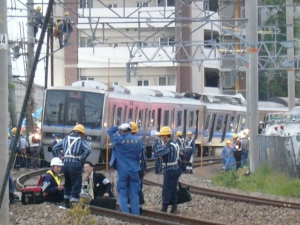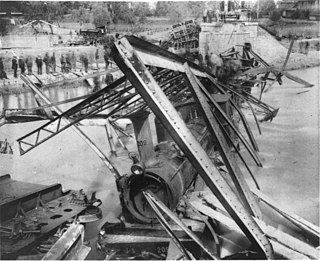
The Quintinshill rail disaster was a multi-train rail crash which occurred on 22 May 1915 outside the Quintinshill signal box near Gretna Green in Dumfriesshire, Scotland. It resulted in the deaths of over 200 people and remains the worst rail disaster in British history.

The Abergele rail disaster, which took place near Abergele, North Wales, in August 1868, was the worst railway disaster in Great Britain up till then.

The Amagasaki derailment occurred in Amagasaki, Hyōgo Prefecture, Japan, on 25 April 2005 at 09:19 local time, just after the local rush hour. It occurred when a seven-car commuter train came off the tracks on West Japan Railway Company's Fukuchiyama Line in just before Amagasaki on its way for Dōshisha-mae via the JR Tōzai Line and the Gakkentoshi Line, and the front two cars rammed into an apartment building. The first car slid into the first-floor parking garage and as a result took days to remove, while the second slammed into the corner of the building, being crushed into an L-shape against it by the weight of the remaining cars. Of the roughly 700 passengers on board at the time of the crash, 106 passengers, in addition to the driver, were killed and 562 others injured. Most survivors and witnesses claimed that the train appeared to have been travelling too fast. The incident was Japan's most serious since the 1963 Tsurumi rail accident.

The Harrow and Wealdstone rail crash was a three-train collision at Harrow and Wealdstone station in Wealdstone, Middlesex during the morning rush hour of 8 October 1952. The crash resulted in 112 deaths and 340 injuries, 88 of these being detained in hospital. It remains the worst peacetime rail crash in British history and the second deadliest overall after the Quintinshill rail disaster of 1915.

The Spanish River derailment was a rail transport accident that occurred on 21 January 1910, on the Canadian Pacific Railway (CPR) Webbwood Subdivision, where the railway crosses the Spanish River near the settlement of Nairn near Sudbury, Ontario, Canada. A westbound passenger express train derailed and crashed into the Spanish River bridge, killing at least 43 passengers, though the death count varies. The cause was never established, but was believed to be poor track condition and/or speeding and braking on a curve.
The Hyde railway disaster occurred on 4 June 1943 near the small settlement of Hyde, Otago, New Zealand, on a bend of the Otago Central Railway. At the time, it was New Zealand's worst railway accident; of the 113 passengers on board, 21 were killed and a further 47 were injured. However, just over 10 years later, the Tangiwai disaster took 151 lives on 24 December 1953. The Hyde disaster remains as the second-worst railway accident in New Zealand's history.
There have been a number of train accidents on the railway network of Victoria, Australia. Some of these are listed below.

The Elliot Junction rail accident occurred on 28 December 1906 at Elliot Junction in Forfarshire, Scotland. An express hit the rear of a local passenger train, which was just moving off from the station, killing 22 and injuring 24. The immediate cause was driver error, but a snow blizzard had disrupted services, and the driver received only a light sentence.

The Münchenstein rail disaster on 14 June 1891 was historically the worst railway accident ever to affect Switzerland. A crowded passenger train fell through a girder bridge, killing more than seventy people and injuring many others. The accident occurred on the railway line between Basel and Delémont, near the Bruckgut just below the village centre of Münchenstein, as the train was traversing the bridge across the river Birs.
In the Tcherny railway accident near Tcherny, Russia on 13 July 1882, a train was derailed and more than 40 people killed. This rail accident was one of the 20 most serious accidents before 1953.
The Torre del Bierzo rail disaster occurred on 3 January 1944 near the village of Torre del Bierzo in the El Bierzo region of Spain's León province when three trains collided and caught fire inside a tunnel. Although the official death toll was 78, and at the time it was estimated to be 200–250, the most recent study has estimated it at no more than 100.

The Ongarue railway disaster occurred on 6 July 1923 near the small settlement of Ongarue, near Taumarunui, North Island, New Zealand, when an overnight express ran into a landslip. Of the 200 passengers on board, 17 died and 28 were injured. The disaster marked the first major loss of life in New Zealand railway history; the Christchurch Press noted that each of the previous fatal railway accidents had resulted in no greater loss of life than that resulting from an overturned motor car.

On 20 November 2016, the Indore–Patna Express 19321, a scheduled train from Indore to Patna, derailed near Pukhrayan, Kanpur, India, resulting in at least 150 deaths and more than 150 injuries.









